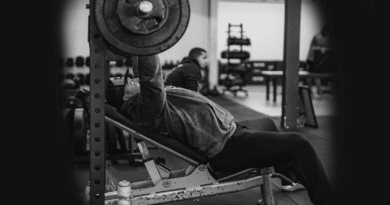
The Simple Weightlifting Basics Every Athlete Should Know
This excellent video from Joe Delaney breaks down the weightlifting basics that result in 90% of all progress when it comes to lifting.
- Video – Weightlifting Basics
- Training
- Nutrition
- Weightlifting Basics – Supplements
- Honourable Mentions
- Important Equipment
- What are Reps and Sets in Weightlifting?
- What are Training Splits in Weightlifting?
- What is Training to Failure in Weightlifting?
- What are Calories?
- Weightlifting Basics – What is a Calorie Deficit?
- Weightlifting Basics – What are Macronutrients?
- Why is Consistency So Important for Weightlifting?
Video – Weightlifting Basics
Training
1:52 4-5 training sessions per week
2:13 follow program + track progression
2:57 training splits
3:26 +16 sets per week for each muscle. 20 is max. Over 20 not worth it.
3:48 proximity to failure (1-3 reps before failure most time – hit reps to failure once/twice per week).
3:59 duration of workout (18 working sets throughout 4-5 exercises. For experienced lifters 24).

Nutrition
4:11 tracking calories = worth for people who cut, less worth for people who bulk.
4:29 protein intake (try +30gr protein per meal + 1 protein snack).
4:34 meal timing/macro separation (don’t worry about it. Total of day is important).
4:58 protein intake per lb bodyweight (0.8-1.0 g/lb).
Weightlifting Basics – Supplements
5:36 whey protein and creatin (best ROI).
6:18 other supplements (not best ROI).
Honourable Mentions
6:38 exercise selection.
6:55 Consistency is KING.
7:36 making gains after few years will be difficult.
7:45 keeping gains will be easy.
Important Equipment
What are Reps and Sets in Weightlifting?
Reps and sets are two important terms in weightlifting and strength training.
A “rep” (short for repetition) is a single instance of performing a specific exercise, such as lifting a weight up and then lowering it back down. For example, if you perform a bicep curl by lifting the weight up towards your shoulder and then lowering it back down, that would be one rep.
A “set” refers to a group of consecutive reps performed without rest. For example, if you perform 10 bicep curls in a row without resting, that would be one set of 10 reps.
In weightlifting, different exercises and goals may require different numbers of reps and sets. For example, if you are trying to build muscular endurance, you may do more reps per set (such as 15-20 reps), while if you are trying to build strength and power, you may do fewer reps per set (such as 1-5 reps). Similarly, the number of sets you do may vary depending on your goals and the specific exercise you are doing.
What are Training Splits in Weightlifting?
In weightlifting and bodybuilding, a “training split” refers to how you divide up your workouts and train different muscle groups on different days. There are various types of training splits, but the most common ones include:
Full body split: This involves training all major muscle groups in a single workout. It is ideal for beginners or those with limited time.
Upper/lower split: This involves training the upper body on one day and the lower body on another day. It is a popular split for building overall strength and size.

Push/pull split: This involves training all pushing exercises (e.g., chest press, shoulder press) on one day and all pulling exercises (e.g., pull-ups, rows) on another day. It is a popular split for targeting specific muscle groups and improving muscle imbalances.
Body part split: This involves training one or two muscle groups per workout, such as chest and triceps or back and biceps. It is a popular split for bodybuilders looking to focus on specific muscle groups and increase muscle mass.
The choice of training split largely depends on your fitness goals, schedule, and personal preferences. It is important to vary your training split periodically to prevent plateaus and to challenge your body in new ways.
What is Training to Failure in Weightlifting?
Training to failure in weightlifting is a technique where you perform an exercise until you are unable to complete another repetition with proper form. This means that you are pushing your muscles to their limit and working them to exhaustion.
When you train to failure, you are putting maximum stress on your muscles, which can lead to greater muscle growth and strength gains over time. However, it is important to use caution when training to failure, as it can also increase the risk of injury and lead to overtraining if not managed properly.
Training to failure should be used strategically and in moderation, and it may not be suitable for everyone. Beginners and those with certain medical conditions or injuries may need to avoid training to failure altogether. It is also important to prioritize proper form and technique, even when pushing your muscles to their limits.
Overall, training to failure can be an effective tool for improving strength and muscle growth, but it should be used with caution and under the guidance of a qualified fitness professional.
What are Calories?
Calories are a unit of measurement used to quantify the amount of energy in food and drinks. In nutrition, a calorie (or kilocalorie, kcal) is defined as the amount of energy needed to raise the temperature of one kilogram of water by one degree Celsius.
The calories in food and drinks come from macronutrients such as carbohydrates, proteins, and fats. Each macronutrient provides a different amount of calories per gram:
- Carbohydrates provide 4 calories per gram
- Proteins provide 4 calories per gram
- Fats provide 9 calories per gram
When we consume food and drinks, our bodies break down the macronutrients into usable energy, which is measured in calories. The number of calories we consume and burn through physical activity and daily metabolism can affect our body weight and overall health.
The number of calories a person needs per day depends on several factors, including age, gender, height, weight, and activity level. The recommended daily calorie intake for an individual can vary greatly, ranging from 1,200 to 3,000 calories or more.
Tracking calorie intake can be useful for weight management and overall health, but it is important to prioritize a balanced diet and lifestyle rather than solely focusing on calorie counting.
Weightlifting Basics – What is a Calorie Deficit?
A calorie deficit is a state in which you consume fewer calories than your body burns. This means that you are creating an energy deficit, forcing your body to use stored energy (such as fat) to meet its energy needs.
When you maintain a calorie deficit over time, your body will start to burn stored energy to make up for the shortfall. This can result in weight loss, as your body is using its own fat stores as a source of energy.
To create a calorie deficit, you can either reduce the number of calories you consume or increase the number of calories you burn through physical activity. This can be achieved through a combination of healthy eating and regular exercise.

It is important to note that a calorie deficit should be achieved in a healthy and sustainable way. Extreme calorie restriction or excessive exercise can be harmful to your health and may lead to nutrient deficiencies, fatigue, and other health problems.
To determine your daily calorie needs and the appropriate calorie deficit for your weight loss goals, it is best to consult with a qualified healthcare professional or registered dietitian. They can help you create a personalized plan that meets your nutritional needs and supports your weight loss goals in a healthy and sustainable way.
Weightlifting Basics – What are Macronutrients?
Macronutrients are nutrients that the body requires in large amounts to function properly and to provide energy. The three main macronutrients are carbohydrates, proteins, and fats.
Carbohydrates are the body’s primary source of energy, and they come in two forms: simple and complex. Simple carbohydrates include sugars such as glucose, fructose, and lactose, which are found in foods like fruits, milk, and sweets. Complex carbohydrates include starches and fibers, which are found in foods like grains, vegetables, and legumes.
Proteins are essential for building and repairing tissues in the body, including muscles, organs, and skin. Proteins are made up of amino acids, which are the building blocks of protein. Foods high in protein include meat, fish, poultry, eggs, beans, and nuts.
Fats are important for energy production and for the absorption of fat-soluble vitamins. There are three main types of fats: saturated, unsaturated, and trans fats. Foods high in fat include oils, butter, cheese, nuts, and fatty meats.
It is important to consume all three macronutrients in the right balance to support overall health and wellbeing. The specific amounts of each macronutrient that a person needs depends on factors like age, gender, activity level, and overall health. A balanced and varied diet that includes a range of nutrient-dense foods is key to meeting these nutritional needs.
Why is Consistency So Important for Weightlifting?
Consistency is crucial in weightlifting because it is what allows for progress and improvement over time. Weightlifting involves challenging the muscles to adapt and grow stronger over time, and this process requires consistent effort and practice.
When you lift weights consistently, your muscles gradually adapt to the stress placed on them, becoming stronger and more efficient. If you lift weights sporadically or inconsistently, your muscles will not have the opportunity to adapt and grow, and you may not see the results you are looking for.

Consistency also helps to build good habits and maintain momentum towards your fitness goals. When you make weightlifting a regular part of your routine, it becomes easier to stick with it over the long term, and you are more likely to see sustained progress and results.
In addition, consistency helps to prevent injury and improve form and technique. When you perform weightlifting exercises consistently, you develop good form and technique, which can help to reduce the risk of injury and allow you to lift heavier weights over time.
Overall, consistency is essential for success in weightlifting. By committing to a regular routine and focusing on gradual improvement over time, you can build strength, increase muscle mass, and achieve your fitness goals.




Pingback: 4 Common Chest Training Mistakes - Outdoor Fitness Society